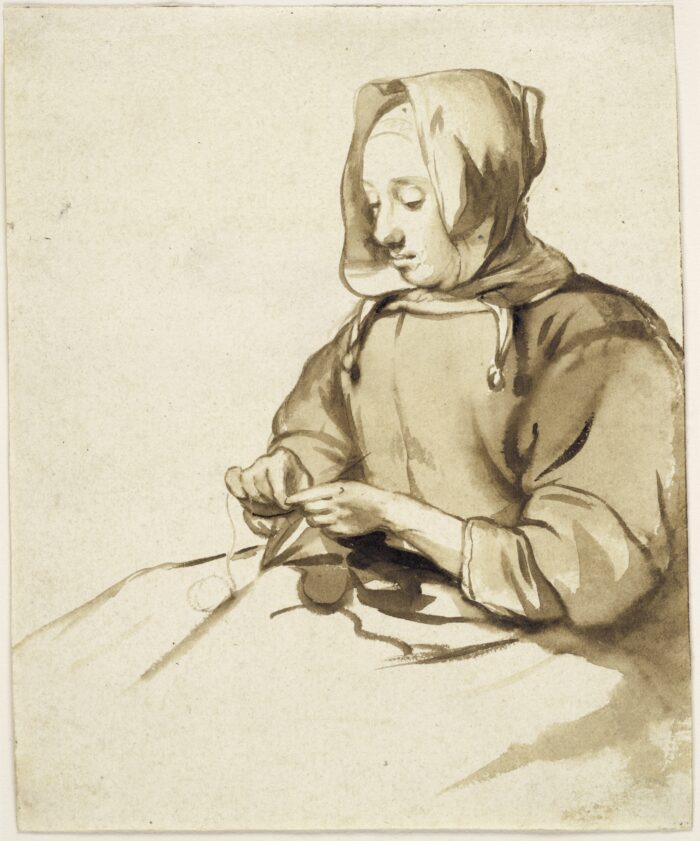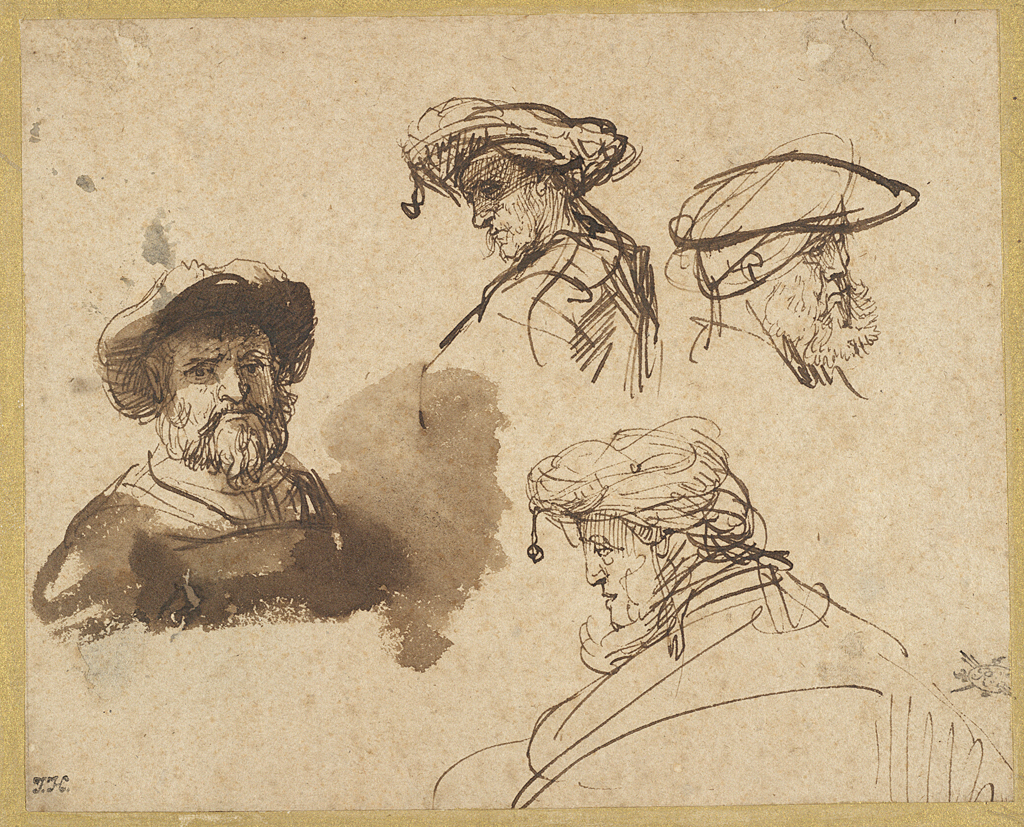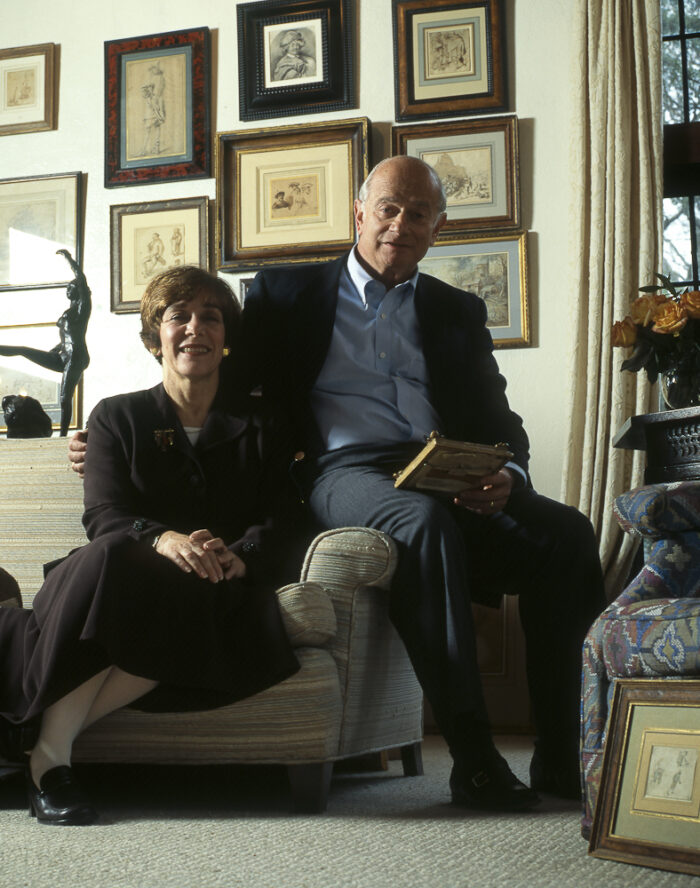This article was originally published in the CODART eZine, no. 1 Autumn 2012.
The American collector George Abrams built up his collection in very close cooperation with his late wife, Maida Stocker Abrams (1938-2002). The Maida and George Abrams Collection is one of the finest collections of Dutch drawings with a focus on the seventeenth century ever brought together in the United States. In addition to his Boston-based legal career, he is a member of the visiting committee of the Harvard Art Museums, a trustee of the Boston Museum of Fine Arts, and a member of the Board and Chairman of the Prints and Drawings vetting committee of TEFAF. Since 2010, George Abrams has supported CODART as a Patron, and he has kindly agreed to tell us more about his passion for Dutch drawings and the history of his collection.
Collection
The decision to build up a collection of drawings (rather than paintings) was unusual when you started to collect in the 1960s. Could you tell us more about it? Why did you focus on drawings, and why Dutch drawings?
Maida and I were drawn to the spontaneity and directness of drawings. We loved the fact that Dutch drawings often depict the world around us: people, animals, landscapes – palpable, touchable things we could see and to which we could relate. In the United States, serious interest in Old Master drawings really developed only in the twentieth century, and initially with an emphasis on Italian and French drawings. Dutch drawings were considered a little pedestrian. We did not agree and happily went off in our own direction. There were very few collectors of Dutch drawings in the United States in the 1960s and 1970s, in part because of fashion and in part because the drawings and most of the dealers were centered in Europe. We had to build our knowledge of the field mostly in Europe, and the extensive traveling this required was not always easy, especially with young children. Books and catalogues and print rooms became a big part of our lives. In the early years there were very few books and catalogues with good illustrations of Dutch Drawings. The only exhibition catalogues were coming from Frits Lugt and Carlos van Hasselt at the Fondation Custodia, occasionally from the Rijksmuseum, and from some of the dealers, such as Colnaghi, C.G. Boerner, Houthakker and Douwes. We studied everything available.
Did you make a deliberate decision at some point to build up a collection? When did you actually begin to call yourself a collector?
No, it really wasn’t a conscious choice. We just went about buying drawings we liked during the 1960s. In 1968, Frank Robinson, whom we knew from the time he was studying at the Fogg, was then teaching at nearby Wellesley College and asked if we would consider doing an exhibition of some of our drawings. We hesitated, but then finally agreed, and Frank produced a small but very lovely catalogue to accompany an exhibition of sixty-three drawings which went to six museums in the United States. We still have and cherish most of the drawings from that exhibition. By that time, we realized we were collectors.

1. Gerbrand van den Eeckhout (1621-1674), A Woman doing Handwork, ca. 1655
Brown ink and brown wash on cream antique laid paper, 179 x 146 mm. The Maida and George Abrams Collection, Fogg Art Museum, Harvard University, Cambridge, Massachusetts, Promised Gift, 25.1998.55
You built up your collection together with your late wife, Maida Stocker Abrams. Can you speak of a “Maida” and a “George” part of the collection or of typical “Maida” or “George” choices?
Maida was more drawn to people and portraits at first. I was too, but along the way I began to appreciate landscapes. Gerbrand van den Eeckhout’s exquisite Woman Doing Handwork (fig. 1) was one of Maida’s favorites, and I was swept up by the two stunning and rare Cornelis Vroom drawings we acquired, one of which is his River Scene (fig. 2). Each of us had the power of veto, but usually we agreed on our choices. Once Maida vetoed the purchase of a portrait by a rare artist of an extremely unattractive man. She said it was possibly the ugliest drawing she had ever seen, and she was right. I got carried away by the rarity.
The advantage of collecting together is that you have different views and that you see other things. It is also hard to collect together, because sometimes you have to decide quickly, and it wasn’t always easy for both of us to see a drawing quickly. Then, I sometimes acted on my own and hoped I would not get into trouble. Luckily, we knew each other’s taste pretty well after the first year or two.

2. Cornelis Vroom (ca. 1591-1661), River Landscape, ca. 1622-23
Brown ink on cream antique laid paper, 181 x 242 mm Maida and George Abrams Collection, Boston, Massachusetts
Drawings
In one of your interviews you spoke about the two levels of a drawing: the “material” and the “spiritual.” Could you tell us about the spiritual level, with one concrete drawing as an example?
I have spoken of the two levels of drawings: the material, physical level and the magical, almost spiritual aura that really wonderful drawings can radiate. It is possible to look at a drawing and see the physical side but not feel anything more. But when I look at a drawing, Jacques de Gheyn’s Gypsy Mother and Child (fig. 3), for example, I feel much more. Look at the way the child holds onto the mother’s finger. Look how they interact – the care and tenderness of the mother and the child’s acceptance of her affection. De Gheyn has done far more than merely depicting a mother and child. He has captured their whole relationship. That is what I mean when I talk of the magical side of drawings.

3. Jacques de Gheyn II (ca. 1565-1625), A Roma Woman with a Child, ca. 1608
Brown ink and black chalk on light tan antique laid paper, 162 x 131 mm. The Maida and George Abrams Collection, Fogg Art Museum, Harvard University, Cambridge, Massachusetts, Promised Gift, 25.1998.10
A lot has been written about your collection. How would you characterize it yourself?
I think I would characterize our collection as one made up of a number of area concentrations. We loved Rembrandt and the people around him. We thought it would be hard for us to collect in this area, but surprisingly we managed to build up a group of nine or ten Rembrandts and about ninety others by his students and circle. We also concentrated on the early draughtsmen around Goltzius and De Gheyn, with a number of drawings by Jan Muller, Jacob Matham, Joachim Wtewael, Willem Buytewech and Jan van Bouckhorst. In the early landscape area we were able to find drawings by Pieter Bruegel the Elder, Hans Bol, C. J. Visscher, Esaias and Jan van de Velde and others. Another concentration was centered around Adriaen van Ostade, his brother Isaak, Cornelis Bega, Cornelis Dusart and other genre artists. We also put together a large group of watercolor still-life artists running from Joris Hoefnagel and Jacob Marrel to Jan Bronkhorst, Aart Schouman and Jan van Huysum. By choice we are weakest in the Italianate Dutch and seascape artists. Our collection is large by today’s standards, close to 700 drawings if you include the Fogg group. I have trouble understanding how it grew to that size when I think of how many times we turned down a drawing with hopes of finding one a little better or more to our taste. But then I remember it has been over fifty years of collecting.
Parallel lives
You have parallel lives: as a lawyer and as an art collector. Can you tell us more about the relationship between these two lives? How do they “feed” each other? In which ways do they compete?
When I was at law school, instead of working summers at law firms in order to advance opportunities for employment, I worked with NBBS in Leiden and elsewhere in Holland in connection with student tourist interchanges, which was an early introduction to the country and its art. Since then, I’ve had an interesting law practice, including working in the United States Senate and being a director of several large corporations. I also developed a number of hotel projects, including one in Amsterdam that took me to Holland on a regular basis for some twenty years. I was able to do some collecting on the side. It’s also true, however, that my law practice sometimes interfered with my collecting. I regret having missed some sales and other buying opportunities because of legal obligations.

4. Rembrandt (1606-1669), Four Studies of Male Heads, ca. 1636
Brown ink and brown wash on cream antique laid paper, 126 x 158 mm. Maida and George Abrams Collection, Boston, Massachusetts
Supporting Cultural Institutions
In 1999 you donated a major part of your collection to the Fogg Art Museum at Harvard University “in recognition of the institution’s leading role as a teaching and research museum.” However, your cooperation with the Fogg goes beyond this donation. You support the Maida and George Abrams Curator of Drawings, CODART member William Robinson. Would you please share with us your reasons for supporting the museum not only by donating works of art, but also by supporting the education of scholars and curators? How do you see the role of CODART in the world of Old Masters aficionados, and why did you decide to join our network as a Patron?
Harvard University had a great tradition of involvement with Old Master drawings. Over the years, I got to know Paul Sachs, Agnes Mongan, Jacob Rosenberg, Seymour Slive, Konrad Oberhuber and Bill Robinson. My involvement with them and with the Fogg Museum has covered the whole period of my collecting from the beginning to the present.
I believed in Harvard’s emphasis on connoisseurship throughout this period, even when connoisseurship was severely attacked in some academic quarters. I have had several other museum involvements, particularly the Museum of Fine Arts, Boston. All my museum involvements have been important to me. I have always wanted to encourage and help as many people as possible to have direct contact with art, just as Maida and I did. Such contact can provide life-changing, humanizing experiences, and I would like to do as much as I can to make access available on a wide scale.
Now, having said that, I believe there is a special world of scholar-curators in the field of Dutch drawings and paintings. I love the research and scholarly side of drawings and have always tried to encourage and support this type of activity. The general public may not be involved in this scholarly world, but it has always fascinated me. When Gary Schwartz first spoke to me about his ideas for CODART, I was totally convinced of the importance of his initiative. One of the things I learned early on was that a curator’s scholarly work can be a lonely pursuit, and Gary’s idea of uniting curators of Dutch and Flemish art in a central organization with regularly held meetings and educational travel opportunities seemed a way to get a more cooperative and supportive environment. Think of how many more interchanges occur now among curators of Dutch and Flemish art. There are even more opportunities for loans, discussions of scholarly work with other knowledgeable people, exhibitions and publications. A lot of this is due to the success of CODART. Gary’s idea has become an important factor in furthering scholarship and in strengthening the work of curators of Dutch and Flemish art all over the world.
Selected Bibliography: Maida and George Abrams Collection
Exhibitions dedicated to the Collection:
Drawings by Rembrandt, his Students and Circle from the Collection of Maida and George Abrams. Greenwich, Connecticut, Bruce Museum, 24 September 2011 – 8 January 2012 and Museum of Fine Arts, Houson, 15 April – 8 July 2012. Catalogue by Peter Sutton and William W. Robinson.
Mirror of Holland: Drawings from the Maida and George Abrams Collection. Boston, Museum of Fine Arts, Part 1, 20 November 2010 – 6 March 2011; Part 2, 26 March – 31 July 2011. No catalogue.
Bruegel to Rembrandt: Dutch and Flemish Drawings from the Maida and George Abrams Collection. London, British Museum, 13 June – 22 September 2002; Paris, Institut Néerlandais, 10 October – 8 December 2002; Cambridge, Massachusetts, Fogg Art Museum, 22 March – 6 July 2003. Catalogue by William W. Robinson.
Seventeenth-Century Dutch Drawings: A Selection from the Maida and George Abrams Collection. Amsterdam, Rijksmuseum, 23 February – 28 April 1991; Vienna, Albertina, 16 May – 30 June 1991; New York, Morgan Library, 22 January – 22 April 1992; Cambridge, Massachusetts, Fogg Art Museum, 10 October – 6 December 1992. Catalogue by William W. Robinson.
Things of This World: A Selection of Drawings from the Collection of Maida and George Abrams. Williamstown, Massachusetts, Sterling and Francine Clark Art Institute, 31 October 1972 – 25 February 1973. Catalogue by Franklin W. Robinson.
Selections from the Collection of Dutch Drawings of Maida & George Abrams, A Loan Exhibition. Hanover, New Hampshire, Hopkins Center Art Galleries, Dartmouth College, 27 March – 18 April 1969; Wellesley, Massachusetts, Wellesley College Museum, 4 May – 4 June 1969; Providence, Rhode Island, Rhode Island School of Design Museum of Art, 17 September – 12 October 1969; Storrs, Connecticut, The University of Connecticut Museum of Art, 18 October – 16 November 1969. Venues added after publication: Princeton, New Jersey, Princeton Museum of Art; Sarasota, Florida, The John and Mable Ringling Museum of Art. Catalogue by Franklin W. Robinson.
Exhibitions to which Mr. and Mrs. Abrams were major contributors:
Jan Lievens. A Dutch Master Rediscovered. Washington, D.C., The National Gallery of Art, 26 October 2008 – 11 January 2009; Milwaukee, The Milwaukee Art Museum, 7 February – 26 April 2009; Amsterdam, Rembrandthuis, 17 May – 9 August 2009. Catalogue by Arthur K. Wheelock and others.
Rembrandt and the Aesthetics of Technique. Cambridge, Massachusetts, Harvard University Art Museums, 9 September – 10 December 2006. Brochure by Ivan Gaskell and William W. Robinson.
Time and Transformation in Seventeenth Century Dutch Art. Poughkeepsie, Frances Lehman Loeb Art Center, Vassar College, 8 April – 19 June 2005; Sarasota, Florida, The John and Mable Ringling Museum of Art, 20 August – 30 October 2005; Louisville, Yhe Speed Art Museum, 10 January – 26 March 2006. Catalogue by Susan Donahue Kuretsky.
From Botany to Bouquets: Flowers in Northern Art. Washington, D.C., The National Gallery of Art, 31 January – 31 May 1999. Catalogue by Arthur K. Wheelock.
From Lowlife to Rustic Idyll: The Peasant Genre in 17th-Century Dutch Drawings and Prints. Cambridge, Massachusetts, 29 March – 22 June 1997. Catalogue by Anna C. Knaap.
Landscape in Perspective: Drawings by Rembrandt and his Contemporaries. Montreal, Montreal Museum of Fine Arts, 15 April – 29 May 1988; Arthur M. Sackler Museum, 20 February – 3 April 1988. Catalogue by Frederik Duparc.
Haarlem, The Seventeenth Century. New Brunswick, New Jersey: The Jane Voorhees Zimmerli Art Museum, Rutgers, The State University of New Jersey, 20 February – 17 April 1983. Catalogue by Frima Fox Hofrichter.
Dutch Seventeenth Century Portraiture: The Golden Age. Sarasota, Florida, The John and Mable Ringling Museum of Art, 4 December 1980 – 8 February 1981. Catalogue by William H. Wilson.
Seventeenth Century Dutch Drawings from American Collections, A Loan Exhibition. Washington, D.C., National Gallery of Art, 30 January – 13 March 1977; Denver, The Denver Art Museum, 1 April – 15 May 1977; Fort Worth, Kimbell Art Museum, 1 June – 15 July 1977. Catalogue by Franklin W. Robinson.
Old Master Drawings from American Collections. Los Angeles, Los Angeles County Museum of Art, 29 April – 13 June 1976. Catalogue by Ebria Feinblatt.
Seventeenth Century Dutch Landscape Drawings and Selected Prints from American Collections. Poughkeepsie, New York, Vassar College Art Gallery, 28 March – 7 May 1976. Catalogue by Curtis O. Baer.
One Hundred Master Drawings from New England Private Collections. Hartford, Connecticut, Wadsworth Atheneum, 5 September – 14 October 1973; Hanover, New Hampshire, Hopkins Center Art Galleries, Dartmouth College, 26 October – 3 December, 1973; Boston, Museum of Fine Arts, Boston, 14 December 1973 – 25 January 1974. Catalogue by Franklin W. Robinson.
Other publications
Abrams, George. “Forum: Cornelis Vroom Gentle Poet of Landscape”, Drawing, vol. 8, no. 4, 1986, pp. 78-9
Abrams, George S. “Collectors and Collecting,” Drawings Defined, New York, 1987, pp. 415-29.
Duparc, Frederick. “Collectie Abrams in Rijksprentenkabinet”, Tableau, vol. 13, no. 5, April 1991, pp. 40ff.
Royalton-Kisch, Martin. “[Review] Seventeenth Century Dutch Drawings. A Selection from the Maida and George Abrams Collection,” The Burlington Magazine, vol. 133, no. 1064, November 1991, pp. 794-5.
Keyes, George. “[Review] Seventeenth Century Dutch Drawings. A Selection from the Maida and George Abrams Collection,” Master Drawings, vol. 30, no. 4, Winter 1991, pp. 443-9.
Plomp, Michiel. “[Review] Bruegel to Rembrandt. Dutch and Flemish Drawings from the Maida and George Abrams Collection,” Oud Holland, vol. 117, no. 1/2, 2004, pp. 99-102.
Schatborn, Peter. “[Review] Bruegel to Rembrandt. Dutch and Flemish Drawings from the Maida and George Abrams Collection,” Master Drawings, vol. 42, no. 3, Autumn 2004, pp. 258-61.
Rubinstein, Gregory. “[Review] Rembrandt Drawings, Greenwich, Connecticut,” The Burlington Magazine, vol. 154, no. 1306, January 2012.

